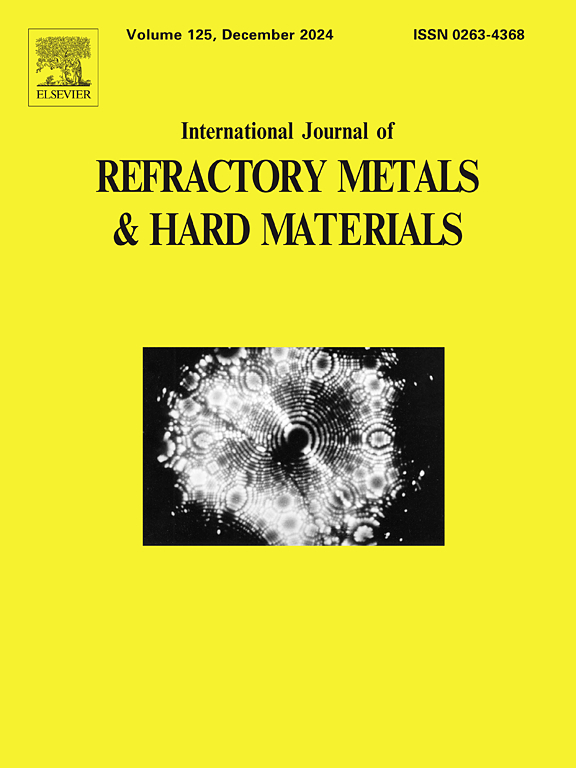A theoretical and numerical investigation of residual stress in thermally sprayed WC-Co coating using nanoindentation technique
IF 4.2
2区 材料科学
Q2 MATERIALS SCIENCE, MULTIDISCIPLINARY
International Journal of Refractory Metals & Hard Materials
Pub Date : 2025-05-19
DOI:10.1016/j.ijrmhm.2025.107242
引用次数: 0
Abstract
Thermally sprayed cermet coating has become a potential substitution for hard chrome plating as it possesses promising mechanical and tribological properties that are greatly pompous by the residual stress. The prospect of nanoindentation technique to assess the residual stress in WC-based coating is extremely limited. In the current investigation, a large number of nanoindentation experiments are conducted on the HVOF deposited WC-Co coating to assess the indentation behaviours of WC phases. A theoretical model based on the constant indentation load approach is established to evaluate the residual stresses from the indentation characteristics. It is observed that the contemplated model has the proficiency to evaluate the residual stress certainly for thermally sprayed WC-Co coating with a mean error of around 13 %. A slight difference in measured residual stress using nanoindentation technique with theoretical model and XRD technique is noted. This is ascribed to the existence of prismatic and basal planes of WC phases that possess different nanoindentation characteristics. On the other hand, FEM-reverse algorithm coupled with MATLAB optimaization tool is employed to evaluate the stress-strain relationship of WC phase from its nanoindentation responses. Based on those results, 2D axisymmetric FE models for both stress-free and samples with compressive stress are developed. By performing the sensitivity analysis, it is conceived that a mesh size of 10 nm can lead to a more defined and uniform stress field. The residual stress obtained from numerical analysis are verified with the experimental findings and an average error of around 15 % is observed. Furthermore, nanoindentation technique is a promising approach that is accomplished to perform residual stress depth profile of the coating. Measurements can be conducted on polished cross-section of coating without affecting the coating integrity. Therefore, the proposed technique represents a convenient and non-destructive approach for residual stress depth profiling of thermally sprayed WC-Co coating.
采用纳米压痕技术对热喷涂WC-Co涂层残余应力进行了理论和数值研究
热喷涂陶瓷涂层由于具有良好的机械性能和摩擦学性能,已成为硬铬镀的潜在替代品。纳米压痕技术评价wc基涂层残余应力的前景非常有限。在目前的研究中,对HVOF沉积的WC- co涂层进行了大量的纳米压痕实验,以评估WC相的压痕行为。建立了基于恒压痕载荷法的理论模型,从压痕特性出发计算残余应力。结果表明,所建立的模型能够准确地估计热喷涂WC-Co涂层的残余应力,平均误差约为13%。采用纳米压痕技术与理论模型和XRD技术测量的残余应力有细微差异。这是由于WC相的棱柱面和基面具有不同的纳米压痕特征。另一方面,利用有限元反演算法结合MATLAB优化工具,从WC相的纳米压痕响应来评估WC相的应力-应变关系。在此基础上,建立了无应力和有压应力试样的二维轴对称有限元模型。通过进行灵敏度分析,可以设想10 nm的网格尺寸可以导致更明确和均匀的应力场。数值分析得到的残余应力与实验结果相吻合,平均误差在15%左右。此外,纳米压痕技术是实现涂层残余应力深度分布的一种很有前途的方法。可以在不影响涂层完整性的情况下对涂层的抛光截面进行测量。因此,该技术为热喷涂WC-Co涂层的残余应力深度分析提供了一种方便、无损的方法。
本文章由计算机程序翻译,如有差异,请以英文原文为准。
求助全文
约1分钟内获得全文
求助全文
来源期刊
CiteScore
7.00
自引率
13.90%
发文量
236
审稿时长
35 days
期刊介绍:
The International Journal of Refractory Metals and Hard Materials (IJRMHM) publishes original research articles concerned with all aspects of refractory metals and hard materials. Refractory metals are defined as metals with melting points higher than 1800 °C. These are tungsten, molybdenum, chromium, tantalum, niobium, hafnium, and rhenium, as well as many compounds and alloys based thereupon. Hard materials that are included in the scope of this journal are defined as materials with hardness values higher than 1000 kg/mm2, primarily intended for applications as manufacturing tools or wear resistant components in mechanical systems. Thus they encompass carbides, nitrides and borides of metals, and related compounds. A special focus of this journal is put on the family of hardmetals, which is also known as cemented tungsten carbide, and cermets which are based on titanium carbide and carbonitrides with or without a metal binder. Ceramics and superhard materials including diamond and cubic boron nitride may also be accepted provided the subject material is presented as hard materials as defined above.

 求助内容:
求助内容: 应助结果提醒方式:
应助结果提醒方式:


